Drug Catalog - Product Detail
PALIPERIDONE ER TAB 3MG 30CT
| NDC | Mfr | Size | Str | Form |
|---|---|---|---|---|
| 43975-0350-03 | ANI PHARMACEUTICALS | 30 | 3MG | NA |
PACKAGE FILES
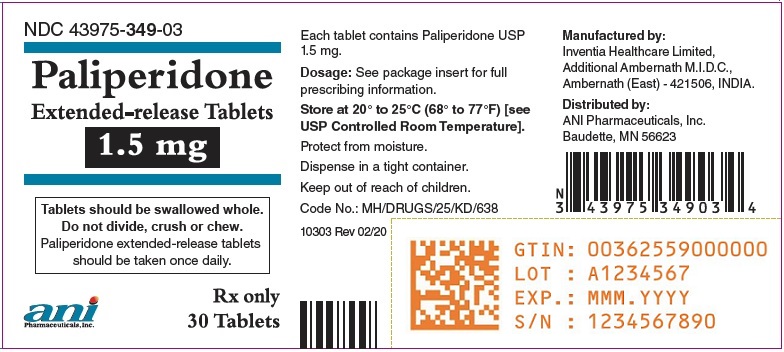
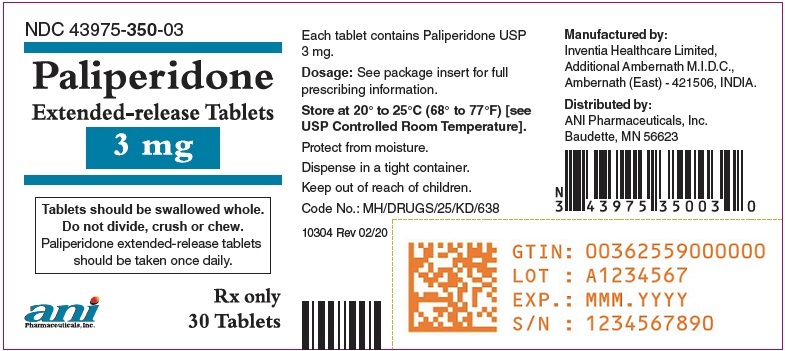
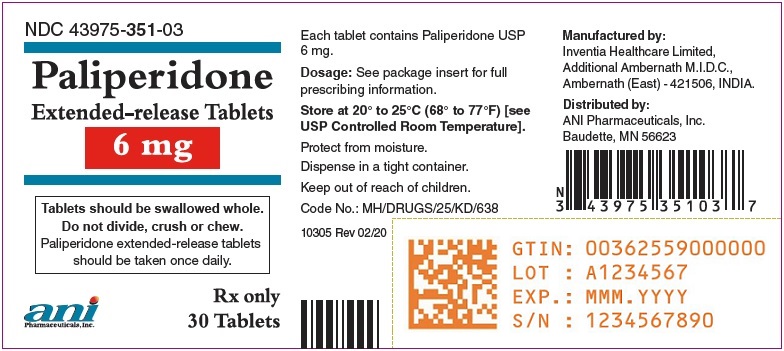
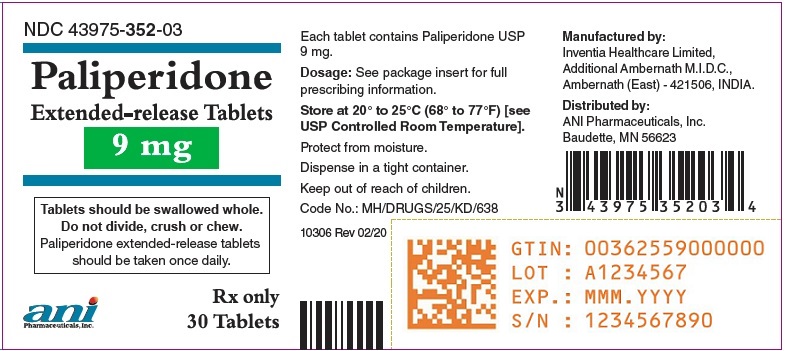
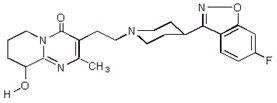
Generic Name
PALIPERIDONE
Substance Name
PALIPERIDONE
Product Type
HUMAN PRESCRIPTION DRUG
Route
ORAL
Application Number
ANDA204452
Description
11. DESCRIPTION Paliperidone extended-release tablets contain paliperidone, an atypical antipsychotic belonging to the chemical class of benzisoxazole derivatives. Paliperidone contains a racemic mixture of (+)- and (-)- paliperidone. The chemical name is (±)-3-[2-[4-(6-fluoro-1,2-benzisoxazol-3-yl)-1-piperidinyl]ethyl]-6,7,8,9-tetrahydro-9-hydroxy-2-methyl-4H-pyrido[1,2-a]pyrimidin-4-one. Its molecular formula is C 23 H 27 FN 4 O 3 and its molecular weight is 426.49. The structural formula is: Paliperidone is sparingly soluble in 0.1N HCl and methylene chloride; practically insoluble in water, 0.1N NaOH, and hexane; and slightly soluble in N,N-dimethylformamide. Paliperidone extended-release tablets are intended for oral administration and are available in 1.5 mg (orange-brown), 3 mg (white), 6 mg (beige), and 9 mg (pink) strengths. Paliperidone extended-release tablets utilize coated matrix drug-release technology . Inactive ingredients are butylated hydroxytoluene, carbomer homopolymer, colloidal silicon dioxide, dibutyl sebacate, ethyl cellulose, hypromellose phthalate, magnesium stearate, microcrystalline cellulose, polyethylene oxides, talc, titanium dioxide. The 1.5 mg and 6 mg tablets also contain ferric oxide yellow and ferric oxide red. The 9 mg tablets contain ferric oxide red. Delivery System Components and Performance Paliperidone extended-release tablets uses coated matrix formulation to deliver paliperidone at a controlled rate. The delivery system which resembles the round shape tablet in appearance consists of active in a core surrounded by a semipermeable membrane. The matrix core is composed of the drug, release controlling polymers and excipients. The semipermeable membrane surrounding the core consists of polymers. Each tablet strength has a different colorant and printing markings. In an aqueous environment, such as the gastrointestinal tract, aqueous fluid enters the tablets core through semipermeable membrane that controls the rate at which aqueous medium enters the tablet core, which in turn determine the lag of drug delivery. The hydrophilic polymers of the core hydrates, swells, creating a gel containing paliperidone which in turn determine the rate of drug delivery. structure
How Supplied
16. HOW SUPPLIED/STORAGE AND HANDLING Paliperidone extended-release tablets are available in the following strengths and packages. All tablets are circular shaped. 1.5 mg tablets are orange-brown colored, circular shaped, biconvex, beveled edged, coated tablet plain on one side and "032" printed in black ink on other side, and are available in bottles of 30 (NDC 43975-349-03). 3 mg tablets are white to off-white colored, circular shaped, biconvex, beveled edged, coated tablet plain on one side and "033" printed in black ink on other side, and are available in bottles of 30 (NDC 43975-350-03). 6 mg tablets are beige colored, circular shaped, biconvex, beveled edged, coated tablet plain on one side and "034" printed in black ink on other side, and are available in bottles of 30 (NDC 43975-351-03). 9 mg tablets are pink colored, circular shaped, biconvex, beveled edged, coated tablet plain on one side and "035" printed in black ink on other side, and are available in bottles of 30 (NDC 43975-352-03). Storage and Handling Store at 20º to 25ºC (68º to 77ºF) [see USP Controlled Room Temperature] . Protect from moisture. Dispense in a tight container. Keep out of reach of children.
Indications & Usage
1. INDICATIONS AND USAGE Paliperidone is an atypical antipsychotic agent indicated for Treatment of schizophrenia ( 1.1 ) Adults: Efficacy was established in three 6-week trials and one maintenance trial. ( 14.1 ) Adolescents (ages 12-17): Efficacy was established in one 6-week trial. ( 14.1 ) Treatment of schizoaffective disorder as monotherapy and as an adjunct to mood stabilizers and/or antidepressants ( 1.2 ) Efficacy was established in two 6-week trials in adult patients ( 14.2 ) 1.1 Schizophrenia Paliperidone extended-release tablets are indicated for the treatment of schizophrenia [see Clinical Studies (14.1) ]. The efficacy of paliperidone in schizophrenia was established in three 6-week trials in adults and one 6-week trial in adolescents, as well as one maintenance trial in adults. 1.2 Schizoaffective Disorder Paliperidone extended-release tablets are indicated for the treatment of schizoaffective disorder as monotherapy and an adjunct to mood stabilizers and/or antidepressant therapy [see Clinical Studies (14.2) ]. The efficacy of paliperidone in schizoaffective disorder was established in two 6-week trials in adults.
Dosage and Administration
2. DOSAGE AND ADMINISTRATION Initial Dose Recommended Dose Maximum Dose Schizophrenia - adults (2.1) 6 mg/day 3 - 12 mg/day 12 mg/day Schizophrenia- adolescents (2.1) Weight < 51kg 3 mg/day 3 - 6 mg/day 6 mg/day Weight ≥ 51kg 3 mg/day 3 - 12 mg/day 12 mg/day Schizoaffective disorder - adults (2.2) 6 mg/day 3 - 12 mg/day 12 mg/day Tablet should be swallowed whole and should not be chewed, divided, or crushed. ( 2.3 ) 2.1 Schizophrenia Adults The recommended dose of paliperidone extended-release tablets for the treatment of schizophrenia in adults is 6 mg administered once daily. Initial dose titration is not required. Although it has not been systematically established that doses above 6 mg have additional benefit, there was a general trend for greater effects with higher doses. This must be weighed against the dose-related increase in adverse reactions. Thus, some patients may benefit from higher doses, up to 12 mg/day, and for some patients, a lower dose of 3 mg/day may be sufficient. Dose increases above 6 mg/day should be made only after clinical reassessment and generally should occur at intervals of more than 5 days. When dose increases are indicated, increments of 3 mg/day are recommended. The maximum recommended dose is 12 mg/day. In a longer-term study, paliperidone has been shown to be effective in delaying time to relapse in patients with schizophrenia who were stabilized on paliperidone for 6 weeks [see Clinical Studies (14) ]. Paliperidone should be prescribed at the lowest effective dose for maintaining clinical stability and the physician should periodically reevaluate the long-term usefulness of the drug in individual patients. Adolescents (12-17 years of age) The recommended starting dose of paliperidone extended-release tablets for the treatment of schizophrenia in adolescents 12-17 years of age is 3 mg administered once daily. Initial dose titration is not required. Dose increases, if considered necessary, should be made only after clinical reassessment and should occur at increments of 3 mg/day at intervals of more than 5 days. Prescribers should be mindful that, in the adolescent schizophrenia study, there was no clear enhancement to efficacy at the higher doses, i.e., 6 mg for subjects weighing less than 51 kg and 12 mg for subjects weighing 51 kg or greater, while adverse events were dose-related. 2.2 Schizoaffective Disorder The recommended dose of paliperidone extended-release tablets for the treatment of schizoaffective disorder in adults is 6 mg administered once daily. Initial dose titration is not required. Some patients may benefit from lower or higher doses within the recommended dose range of 3 to 12 mg once daily. A general trend for greater effects was seen with higher doses. This trend must be weighed against dose-related increase in adverse reactions. Dosage adjustment, if indicated, should occur only after clinical reassessment. Dose increases, if indicated, generally should occur at intervals of more than 4 days. When dose increases are indicated, increments of 3 mg/day are recommended. The maximum recommended dose is 12 mg/day. 2.3 Administration Instructions Paliperidone extended-release tablets can be taken with or without food. Paliperidone extended-release tablets must be swallowed whole with the aid of liquids. Tablets should not be chewed, divided, or crushed. 2.4 Use with Risperidone Concomitant use of paliperidone with risperidone has not been studied. Since paliperidone is the major active metabolite of risperidone, consideration should be given to the additive paliperidone exposure if risperidone is coadministered with paliperidone. 2.5 Dosage in Special Populations Renal Impairment Dosing must be individualized according to the patient’s renal function status. For patients with mild renal impairment (creatinine clearance ≥ 50 mL/min to < 80 mL/min), the recommended initial dose of paliperidone is 3 mg once daily. The dose may then be increased to a maximum of 6 mg once daily based on clinical response and tolerability. For patients with moderate to severe renal impairment (creatinine clearance ≥ 10 mL/min to < 50 mL/min), the recommended initial dose of paliperidone is 3 mg every other day or 1.5 mg once daily, which may be increased to a maximum of 3 mg once daily after clinical reassessment. As paliperidone has not been studied in patients with creatinine clearance below 10 mL/min, use is not recommended in such patients. [See Clinical Pharmacology (12.3) ] Hepatic Impairment For patients with mild to moderate hepatic impairment, (Child-Pugh Classification A and B), no dose adjustment is recommended [See Clinical Pharmacology (12.3) ]. Paliperidone has not been studied in patients with severe hepatic impairment. Elderly Because elderly patients may have diminished renal function, dose adjustments may be required according to their renal function status. In general, recommended dosing for elderly patients with normal renal function is the same as for younger adult patients with normal renal function. For patients with moderate to severe renal impairment (creatinine clearance 10 mL/min to < 50 mL/min), the maximum recommended dose of paliperidone is 3 mg once daily [see Renal Impairment above].
